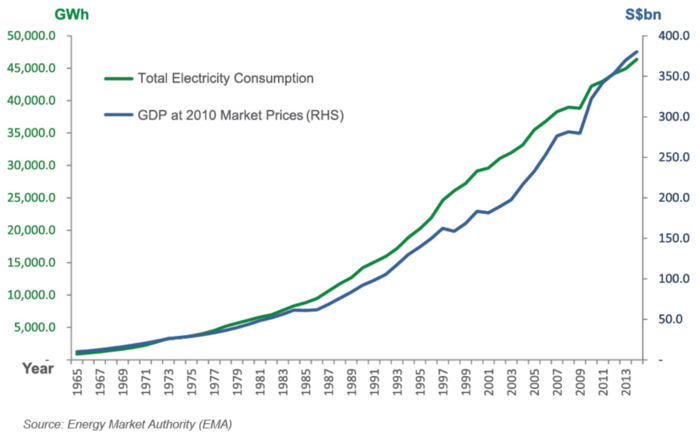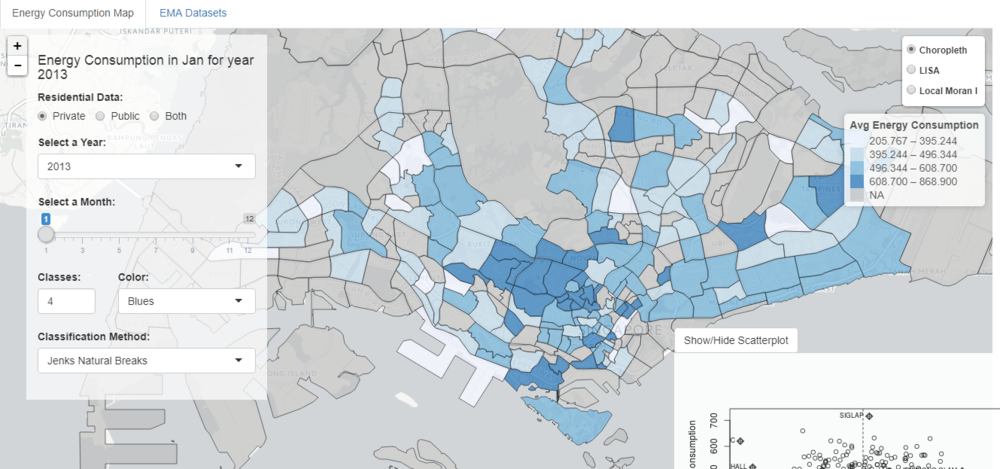1718t1is428T15
|
PROJECT PROPOSAL |
Contents
Project Motivation
Experts have warned that power demand is set to double by 2030 globally despite authoritative control. High power consumption can already be observed locally. According Energy Market Authority (EMA), Singapore has faced increasing power consumption from 1965 to 2013 [1].
As Singapore is land-scarce and does not have significant renewable energy options such as hydro-power, wave, or sufficient land for mass solar energy production, energy has been a top concern in the urban nation[2]. It is thus important to promote energy saving concepts to the public as well as deploying energy saving solution island wide. However, the usual analysis tools are not enough to provide a different perspective to facilitate the deployment of the solution. Information about the energy consumption levels of residents in Singapore are often not conveyed adequately enough in data visualisation. While EMA and Singstat provide annual data and reports on energy usage in Singapore, a powerful visualisation technique should be used to gain insights effectively.
Project Objective
Our team aims to create a visualisation that leverages on energy datasets provided by EMA to perform spatial analysis to identify energy usage clusters with hexagonal binning.
Dataset
The analysis will be based on EMA dataset:
- Public housing's average monthly household electricity consumption (kwh) (2013 - 2015)
- Private apartment's average monthly household electricity consumption (kwh) (2013 - 2015)
Related Works
Inspirations
The number of public and private address points in Singapore is exceptionally large at about twenty thousands records. While this may pale in comparison to data sets that amount to tens of millions of records in size, the real challenge lies in plotting these points over a geographical region as small as Singapore. The limitation in land space coupled with the immense number of data points would result in many overlapping and cluttering of address points, making data aggregation and visualizing energy consumption extremely difficult and ineffective.
Our team has already experimented aggregating energy consumption levels onto a choropleth map segmented by planning areas. This approach is effective in providing an overview of energy consumption levels across planning areas in Singapore, further assisting analysis in local indications of spatial correlation in terms of energy usage clustering. However, this approach is inept at investigating clustering at finer levels of spatial granularity, focusing on smaller areas is impossible as data is aggregated at the level of planning areas.
With this in mind, On The Fly is experimenting with an alternative technique of hexagonal binning for visualizing energy usage density of public and private housings. By aggregating the number of address points into hexagons and computing the average energy consumption of address points in these hexagons, we aim to visualize energy consumption levels of address points aggregated across smaller areas in hex bins to generate a more detailed view of energy usages across geographical land space.
Proposed Storyboard
Technical Challenges
Timeline
| Week No(s). | Task | Status |
|---|---|---|
| 3 | Form team | Completed |
| 4-5 | Discuss and choose a project topic | Completed |
| 6-9 | Research chosen project topic and data collection | Completed |
| 10-11 | Create project repository and web application planning | Completed |
| 12 | Create project wiki | Completed |
| 11-15 | Develop application | Completed |
| 14-15 | Research report | Completed |
| 16 | Finalize application | Completed |
| 16 | Finalize Poster and Research Paper | Completed |
| 16 | Prepare for Townhall Presentation | Completed |
| 16 | Townhall Poster Presentation | Completed |
| 16 | Final Project Submission | Completed |
Technologies/Tools
Reference
Comments


